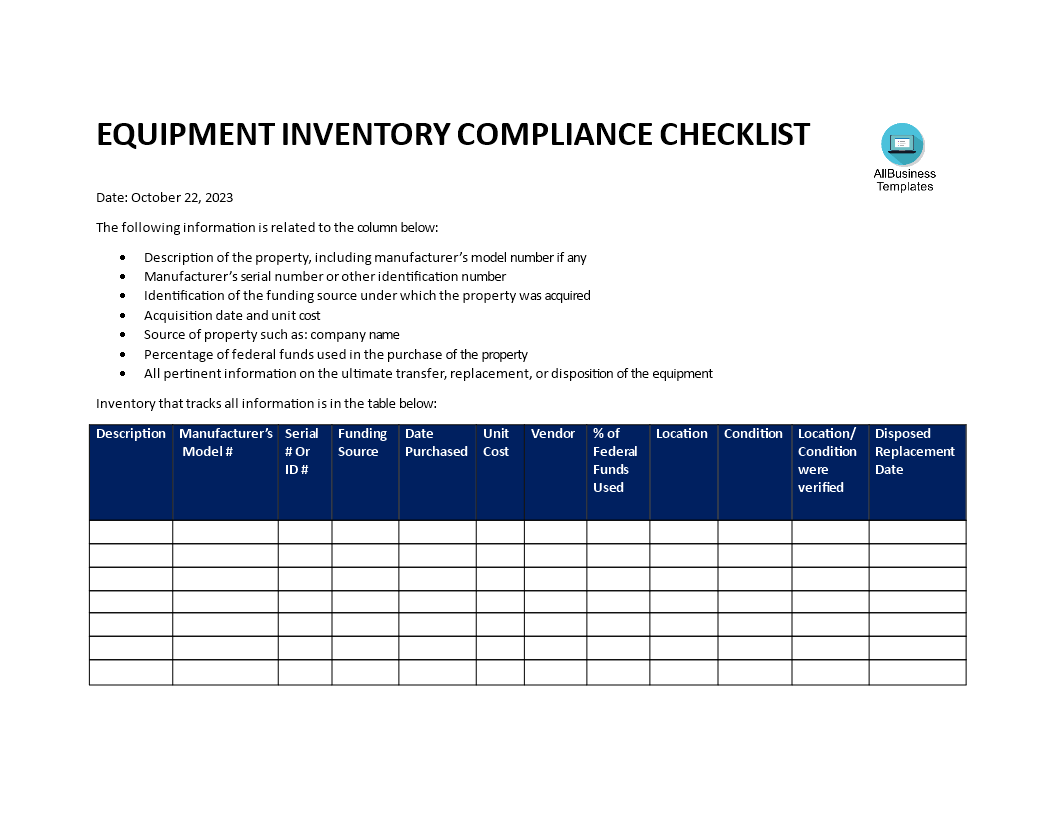Equipment Inventory List
Save, fill-In The Blanks, Print, Done!

Download Equipment Inventory List
Microsoft Word (.docx)Or select the format you want and we convert it for you for free:
Other languages available:
- This Document Has Been Certified by a Professional
- 100% customizable
- This is a digital download (27.74 kB)
- Language: English
- We recommend downloading this file onto your computer.
How to create an Equipment Inventory List? What is the process for making an inventory of equipment? You can download a sample template from our page. The template includes fields for item name, description, location, quantity, and value. Get this template now and start your equipment inventory listing now!
An equipment inventory list, also known as an equipment inventory or asset inventory, is a comprehensive document that provides a detailed record of all the equipment and assets owned or managed by an organization, business, or individual. This list serves as a critical tool for tracking, managing, and maintaining assets, ensuring accountability, and assisting with financial and operational planning. Equipment can include everything from office furniture and computers to heavy machinery and vehicles, depending on the organization's nature and needs.
Here are key elements typically included in an equipment inventory list:
- Asset Identification:
- A unique identification number or code for each piece of equipment to distinguish one from another.
- Asset Description:
- A detailed description of the equipment, including its make, model, brand, serial number, and any other relevant information.
- Date of Acquisition:
- The date when the equipment was acquired or purchased by the organization.
- Purchase Price:
- The cost of acquiring the equipment can be useful for accounting and depreciation purposes.
- Location:
- The physical location or department where the equipment is currently situated.
- Condition:
- The current condition or status of the equipment, such as "new," "used," "in need of repair," or "out of service."
- Depreciation Value:
- The calculated depreciation value of the equipment if applicable. This helps in financial reporting and tax purposes.
- Assigned User:
- The name or department of the individual responsible for the equipment.
- Maintenance Records:
- Details of maintenance and service history, including dates of servicing, repairs, and relevant maintenance notes.
- Warranty Information:
- Any warranty or service agreements associated with the equipment, including expiration dates.
- Insurance Information:
- Details of any insurance coverage or policies that pertain to the equipment.
- Supplier/Vendor Information:
- Information about the supplier or vendor from which the equipment was purchased.
Regular updates and maintenance of the equipment inventory list are essential to ensure its accuracy and usefulness. Modern asset management software or tools can also be employed to streamline the process and enhance efficiency in maintaining and accessing the inventory list.
Download this Equipment Inventory List Excel or Google Sheets template now for your own benefit!
DISCLAIMER
Nothing on this site shall be considered legal advice and no attorney-client relationship is established.
Leave a Reply. If you have any questions or remarks, feel free to post them below.
Related templates
Latest templates
Latest topics
- Counter Offer Letter Templates
How to counter an offer , for example a job offer? Finding the Right Counter Offer Letter Example (With Free Templates) - Celcius To Farenheit Chart
How to convert celcius to farenheit? Celsius to Fahrenheit conversion charts and streamline your temperature calculations and conversions here. - Formal Complaint Letter of Harrasment
How do I write a formal complaint about harassment? Check out these formal complaint letter of harrasment templates here! - Google Sheets Templates
How to work with Google Sheets templates? Where to download useful Google Sheets templates? Check out our samples here. - Letter Format
How to format a letter? Here is a brief overview of common letter formats and templates in USA and UK and get inspirited immediately!
cheese

